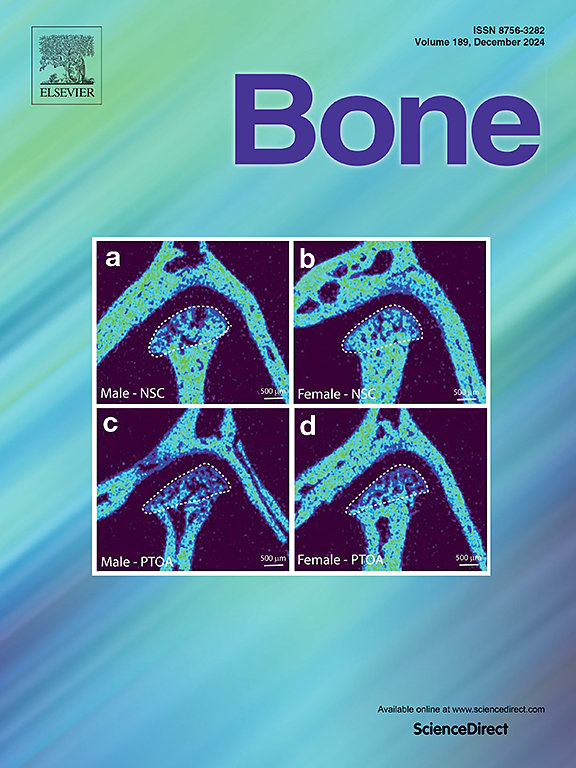Mineralised bone properties in a child with recessive osteogenesis imperfecta type XIV and in a conditional Tmem38b knockout murine model (Runx2-Cre; Tmem38bfl/fl)
IF 3.5
2区 医学
Q2 ENDOCRINOLOGY & METABOLISM
引用次数: 0
Abstract
Introduction
OI type XIV is caused by variants in the TMEM38B gene, encoding for the ubiquitously expressed endoplasmic reticulum trimeric intracellular cation channel type B (TRIC-B), causing disruptions in calcium homeostasis and collagen synthesis. Patients with OI type XIV present with a highly variable clinical phenotype, ranging from asymptomatic to severe. We present here data from a 6 year clinical follow-up of two affected siblings and bone tissue characterisation obtained during corrective surgery from one of the patients, as well as tibiae from a novel Tmem38b conditional knockout murine model (Runx2-Cre; Tmem38bfl/fl).
Methods
Clinical examinations of the patients include bone mineral density (BMD) measurements using dual-energy x-ray absorptiometry (DXA) scanning and gait analyses. Quantitative backscattered electron imaging (qBEI) was used to investigate bone mineralisation density distribution (BMDD) and osteocyte lacunae properties, and confocal laser scanning microscopy was used to quantify the osteocyte lacuno-canalicular network (OLCN) in both human and murine specimens.
Results
Both patients (P1, P2) presented with muscular hypotension, fatigue, progression of lower limb deformities, and fractures. BMDD of the osteonal bone region of the tibia and fibula specimens obtained from P1 revealed no significant shift towards higher mineral content as seen in “classical” OI. Osteocyte lacunae porosity was elevated and analyses of the OLCN revealed a reduction in canalicular density and lacunar degree. Runx2-Cre; Tmem38bfl/fl mice exhibited a very severe skeletal phenotype, with 10/12 of the tibiae showing evidence of fractures, bone deformations, or calluses. In contrast to the patient samples, both the cortex and metaphysis of mutant mice demonstrated a significant increase in the average mineral content (CaMean) and the peak of the distribution (CaPeak), as well as in osteocyte lacunae porosity (P < 0.0001), whereas canalicular density (P < 0.0001), and lacunar degree (P = 0.0004) were decreased.
Conclusion
While Runx2-Cre; Tmem38bfl/fl mice exhibit hypermineralisation of the bone matrix, this is not apparent in bone specimens obtained from the OI type XIV patient. However, both human and murine bone tissue with absence of TRIC-B demonstrate the same abnormalities of the osteocyte lacunae porosity and osteocyte lacuno-canalicular network, indicating disruption to the OLCN which is likely a general hallmark of OI bone.

隐性成骨不全XIV型儿童和条件Tmem38b敲除小鼠模型(Runx2-Cre;Tmem38bfl / fl)。
导语:OI型XIV是由TMEM38B基因变异引起的,该基因编码普遍表达的内质网三聚体细胞内阳离子通道B型(trici -B),导致钙稳态和胶原合成中断。XIV型成骨不全患者具有高度可变的临床表型,从无症状到严重。我们在此提供了对两名受影响的兄弟姐妹进行6 年临床随访的数据,以及其中一名患者在矫正手术期间获得的骨组织特征,以及来自新型Tmem38b条件敲除小鼠模型(Runx2-Cre;Tmem38bfl / fl)。方法:临床检查采用双能x线骨密度仪(DXA)扫描测量骨密度(BMD)和步态分析。定量背散射电子成像(qBEI)用于研究骨矿化密度分布(BMDD)和骨细胞腔隙特性,共聚焦激光扫描显微镜用于量化人和小鼠标本中的骨细胞腔隙-管状网络(OLCN)。结果:两例患者(P1, P2)均出现肌肉低血压、疲劳、下肢畸形进展和骨折。从P1获得的胫骨和腓骨标本的骨区BMDD显示,在“典型”成骨不全中,矿物质含量没有明显的增加。骨细胞腔隙孔隙度升高,OLCN分析显示腔隙密度和腔隙度降低。Runx2-Cre;Tmem38bfl/fl小鼠表现出非常严重的骨骼表型,10/12的胫骨显示出骨折、骨变形或老茧的证据。与患者样本相比,突变小鼠的皮质和干骺端平均矿物质含量(CaMean)和分布峰值(CaPeak)以及骨细胞腔隙孔隙度(P )均显著增加。Tmem38bfl/fl小鼠表现出骨基质高矿化,这在从XIV型OI患者获得的骨标本中并不明显。然而,缺少trici - b的人和小鼠骨组织都表现出骨细胞腔隙孔隙和骨细胞腔隙-小管网络的相同异常,表明OLCN的破坏可能是成骨不全的一般标志。
本文章由计算机程序翻译,如有差异,请以英文原文为准。
求助全文
约1分钟内获得全文
求助全文
来源期刊

Bone
医学-内分泌学与代谢
CiteScore
8.90
自引率
4.90%
发文量
264
审稿时长
30 days
期刊介绍:
BONE is an interdisciplinary forum for the rapid publication of original articles and reviews on basic, translational, and clinical aspects of bone and mineral metabolism. The Journal also encourages submissions related to interactions of bone with other organ systems, including cartilage, endocrine, muscle, fat, neural, vascular, gastrointestinal, hematopoietic, and immune systems. Particular attention is placed on the application of experimental studies to clinical practice.
 求助内容:
求助内容: 应助结果提醒方式:
应助结果提醒方式:


